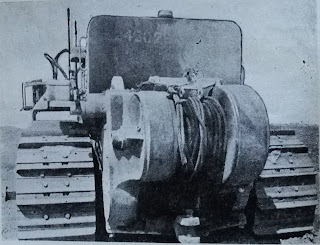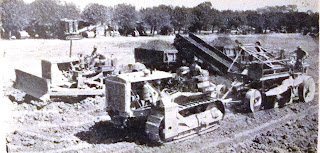Firstly I accept that I am going to labelled a first class anorak with this post. Declaring you have an interest in pillboxes is bad enough but tractors etc?? Anyway the reason for this post follows on from my visit to the TNA last week - highly successful with the highlight being the potential matching of many earthworks I found last winter to a training exercise held in 1943 (that's for future posts though!).
Anyway back to tractors - in one War Diary of Engineers involved firstly in the constrcution of anti-tank ditches on the GHQ line in Essex, before moving to Suffolk, a list of mechanical equipment was given. So I thought this post (and one or two subsequent) may be of interest to give a flavour of the machinery used to construct the anti-invasion defences in Britain. This is part 1 - the D4 and D8 tractor.
No 2 section 135 Mechanical Engineers commenced work on the GHQ Line in Essex on June 18th 1940 with:
- 2 RB19 Dragline
- 5 RB10 Dragline
- 1 1/14 Smith Shovel
- 1 D8 tractor and grader
- 4 D4 tractor and bulldozer.
This post will cover the D4 and D8 tractor and grader. I hope to do the RB 10 and 19 in future posts. I have yet to find out what a Smith Shovel is - if anyone knows I would be extremely grateful if you would leave comment.
The most widely used 'caterpillar self-laying' tractor equipment by the Army during WW2 were the D4, D6, D7 and D8 tractors.
So sticking to the D4 and D8 mentioned in the War Diary, here is the technical information (you may want to hit the refresh button on your browsers now!!):
D4
Horse Power: 35
Speeds forward:
1 - 1.7 mph; 2 - 2.4 mph; 3 - 3 mph; 4 - 3.7 mph; 5 - 5.5 mph
Speeds reverse:
1 - 1.9 mph
Drawbar Pull: 7,852 lbs
Fuel Tank capacity: 25 gallons
Weight: 10,240 lbs
D8
Horse power: 120
Speeds forward:
1- 1.6 mph; 2 - 2.2mph; 3 - 2.6 mph; 4 - 3.0 mph; 5 - 3.6 mph; 6 - 4.0 mph
Speeds reverse:
1 - 1.6 mph; 2 - 2.2 mph
Drawbar Pull: 26,208 lbs
Fuel Tank capacity: 50 gallons
Weight: 34,170 lbs
Bulldozer refers to a special alloy high tensile straight steel blade, concave in the vertical plane. A bulldozer blade is permanently set at right angles to the centre line of the tractor. It can be lowered or raised in a vertical plane and could be used for pushing or dozing soils etc in forward direction. It was somewhat limited in its scope compared to the Angledozer which could be set at an angle up to 30 deg or tilted.
Above: Hydraulically Controlled Bulldozer Blade (photo shows it mounted on a D4 tractor, illustrations on a D7)
A grader was similar to a dozer blade but lighter. The War Diary only notes "D8 tractor and grader" so I assume this refers to an elevating grader No48 which was most likely to be towed by a D8. This machine was built up over a stout girder mounted on heavy iron wheels with steel tyres. A wide carrier belt was mounted on the centre of the arch, at right angle to the direction of travel. A steel plough disc loaded soil onto the conveyor belt which which could be discharged into accompanying trailers. A No 48 Grader needed a tractor with up to 120 HP to tow it.
Above: An elevating grader, towed by a D8 tractor, loading Athey Wagons in tandem, drawn by a D8 tractor.
Anyway that's the highlight of the technical details. I am not sure how these tractors would have been used in anti-tank ditch construction but they were certainly used later for levelling sites for camps and aerodromes.
A plea to anyone who may know the answer to this question which would be useful for Part 2 of this blog:
What is skimmer shovel equipment?





Comments
Post a Comment